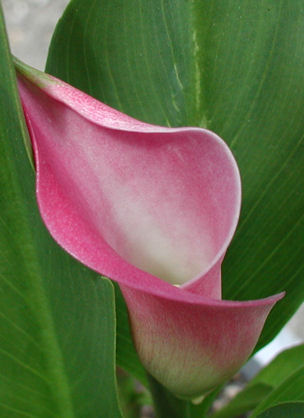
If a plant could have an identity crisis, the Calla Lily would be a good candidate. The common name, Calla Lily, is somewhat misleading, as they are not lilies, not even related to lilies. Calla Lilies belong to the Araceae family. This family includes plants called Calla, but they belong to a different genus, they would be a cousin to this plant. Sometimes these are called Arum Lily, but again, same family, different genus, another cousin. The botanically correct name for this plant would be Zantedeschia, a name which honors Giovanni Zantedeschi, an Italian botanist who died a long time ago. The genus Zentedeschia includes 28 different species of herbaceous flowering perennials.
 No matter what you call them, Calla Lilies are very popular as decorative plants and as cut flowers. Wedding and funeral arrangements frequently include Calla Lilies because they last a long time in water. Gardeners all over the world grow them, though they were originally from the southern parts of Africa, where they grew in marsh areas. They’re not very picky about the where they are planted, as long as the soil is kept damp, but not too damp, and they get at least some sun. It is even possible to adapt Calla Lilies to grow in shallow water, such as a water garden. In some parts of the world, including California, they are considered invasive weeds. The plants grow from rhizomes (a lot of people call them bulbs), and spread by forming more rhizomes. Calla Lilies can be divided and moved fairly easily. In the United States, they grow best in hardiness zones 7-10, but I’ve grown them here in zone 5. The bulbs can be lifted and stored over the winter, similar to dahlias.
No matter what you call them, Calla Lilies are very popular as decorative plants and as cut flowers. Wedding and funeral arrangements frequently include Calla Lilies because they last a long time in water. Gardeners all over the world grow them, though they were originally from the southern parts of Africa, where they grew in marsh areas. They’re not very picky about the where they are planted, as long as the soil is kept damp, but not too damp, and they get at least some sun. It is even possible to adapt Calla Lilies to grow in shallow water, such as a water garden. In some parts of the world, including California, they are considered invasive weeds. The plants grow from rhizomes (a lot of people call them bulbs), and spread by forming more rhizomes. Calla Lilies can be divided and moved fairly easily. In the United States, they grow best in hardiness zones 7-10, but I’ve grown them here in zone 5. The bulbs can be lifted and stored over the winter, similar to dahlias.
The Calla Lily “flower” is actually called a spathe, and the thing is the middle is a spadix. The spathes can be many colors such as white, yellow, green, and numerous shades of pink, red, purple and orange. The spadix is covered with tiny flowers. Plants grow about 2-3 feet tall with leaves that are glossy and arrow shaped, some with spots. All species require some kind of rest period, a time when they are dormant. Some lose their leaves during this time, and others are evergreen. All parts of the plant are poisonous. The poison, oxalic acid, can actually kill livestock and small children who eat it. Who would have thought that this beautiful flower could be so dangerous?
